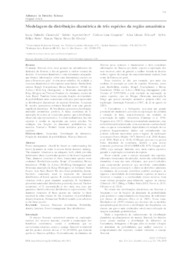Modelagem da distribuição diamétrica de três espécies da região amazônica.
Modelagem da distribuição diamétrica de três espécies da região amazônica.
Author(s): CIARNOSCHI, L. D.; ORSO, G. A.; CERQUEIRA, C. L.; PELISSARI, A. L.; PÉLLICO NETTO, S.; OLIVEIRA, M. V. N. d'
Summary: O manejo florestal deve estar apoiado no entendimento da dinâmica da floresta, a fim de garantir a melhor tomada de decisão. A estrutura diamétrica é uma ferramenta adequada, que fornece informações sobre uma determinada espécie ou para a floresta em geral. Assim, neste trabalho, foi avaliada a estrutura diamétrica de três espécies amazônicas: Bertholletia excelsa Bonpl. (Castanheira), Hevea brasiliensis (Willd. ex A.Juss.) Müll.Arg (Seringueira) e Swietenia macrophylla King (Mogno) na Floresta Estadual do Antimary, estado do Acre, Brasil. Também foram ajustadas funções de densidade de probabilidade mais comumente utilizadas para representar as distribuições diamétricas de espécies florestais. A espécie B. excelsa apresentou estrutura bimodal com uma grande amplitude diamétrica. H. brasiliensis apresentou distribuição unimodal assimétrica positiva. A baixa ocorrência de S. macrophylla na área de estudo não garante que a distribuição observada seja representativa. A estrutura diamétrica das três espécies é similar às reportadas em outros estudos. Na avaliação das funções de densidade probabilística, os modelos Normal e Weibull foram aderentes para as três espécies. Forest management should be based on understanding the forest dynamics in order to ensure better decision making. The diameter structure is an adequate tool, which provides information about a particular species or the forest in general. Thus, diameter structure of three Amazonian species were evaluated: Bertholletia excelsa Bonpl. (Castanheira), Hevea brasiliensis (Willd. Ex A.Juss.) Müll.Arg (Seringueira) and Swietenia macrophylla King (Mahogany) at Antimary State Forest, Acre State, Brazil. We also fitted probability density functions commonly used to represent the diameter distributions of forest species. B. excelsa presented bimodal structure with a great diameter amplitude. H. brasiliensis presented a unimodal distribution positively skewed. The low occurrence of S. macrophylla in the study area does not guarantee that the observed distribution is representative. The diameter structures of three species are similiar to those reported in other studies. In the evaluation of probabilistic density functions, Normal and Weibull models were adherent to the three species.
Publication year: 2019
Types of publication: Journal article
Unit: Embrapa Acre
Keywords: Acre, Administração Florestal, Amazonia Occidental, Amazônia Ocidental, Análise Estatística, Análisis estadístico, Bertholletia Excelsa, Bujari (AC), Castanha do Para, Castanha do brasil, Caucho, Caule, Dendrometria, Diâmetro, Essência Florestal, Forest management, Forest mensuration, Hevea Brasiliensis, Madera tropical, Manejo florestal, Mogno, Ruber tree, Sena Madureira (AC), Seringueira, Statistical analysis, Swietenia Macrophylla, Tropical wood, Western Amazon
Observation
Some of Embrapa's publications are published as ePub files. To read them, use or download one of the following free software options to your computer or mobile device. Android: Google Play Books; IOS: iBooks; Windows and Linux: Calibre.
Access other publications
Access the Agricultural Research Database (BDPA) to consult Embrapa's full library collection and records.
Visit Embrapa Bookstore to purchase books and other publications sold by Embrapa.

